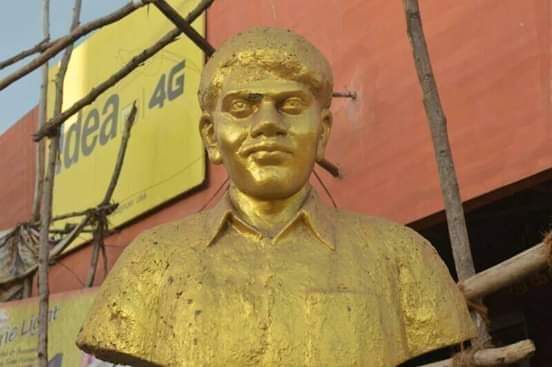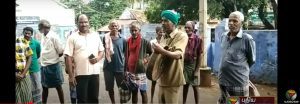
Four decades of Dalit struggle behind TN's 'thandora' drum ban
Thandoras (drum-beaters) have traditionally been Dalits. Activists have been protesting against this practice linked to caste oppression for decades. The TN has banned the practice, only after a long, often violent, struggle

The Tamil Nadu government’s recent move to end the caste-driven traditional practice of making public announcements through thandora (drum-beaters) has been received warmly. The process involves a drummer, or messenger, walking down the street, beating the thandora, a variety of drums, to let the public know something is up. Once the people gather around, key announcements are made.
This work is considered undignified, since it is directly connected to the caste system and oppression. Though many view the state government’s move as proactive, this thorny issue has involved four decades of political and cultural struggle.
Decades of struggle
The job of beating the thandora always fell on the oppressed classes. In Tamil Nadu, members belonging to the Paraiyar community handled the task. In Karnataka, Andhra Pradesh and Telangana, the Madigas do the job. In Odisha, the Dombo community members are roped in for this practice.

Tamil Nadu was the first state to first object to this practice.
Using thandora in a high-tech era shows that social development has still not reached most rural areas, observed Stalin Rajangam, a researcher who writes on Dalit issues. Rajangam told The Federal: “There is a strong relation between the division of labour and the prevailing caste system. Dr Ambedkar said that the caste system is not merely a division of labourers, quite different from a division of labour; it is a hierarchy in which the labourers are graded one above the other. The division of labour is nothing but continuing one’s traditional occupation.”
Also read: An SC woman as Chennai mayor—another milestone in TN history
Rajangam added that Iyothee Thass Pandithar, a pioneering Dalit icon, had said using traditional occupations to club people as ‘untouchables’ gives untouchability a legitimacy and antiqueness. “That was how jobs like burying dead cows, cleaning the drainage, announcing deaths, and manual scavenging became ‘services’ rendered by Dalits. On a similar line, thandora also became the work of the Dalits,” he explained.
Out of SC/ST Act purview
In his research, Rajangam found that government message bearers happen to be Dalits in most cases. This form of caste discrimination did not fall under the purview of the SC/ST (Prevention of Atrocities) Act as well, he said.
So, based on his research, he published an article in Amrutha, a literary and cultural magazine in 2006, to highlight the protests against the practice over the years.
“Since it was only the Dalits who could become thandoras (those who beat the thandora), there were many political protests organised to put pressure on the state government to ban this practice. The protests mostly emerged in the then North Arcot and South Arcot districts (now North Arcot district is broken down into Vellore, Ranipet, Tirupattur and Tiruvannamalai, and South Arcot into Cuddalore, Kallakurichi and Villupuram), where there is a significant population of Dalits. These protests were largely held not under any particular political leadership but as collective protests of various Dalit activists,” he said.
There is a need to document the protests of this kind village-wise. In almost every protest, the activists and organisers have faced violence, become fugitives and landed in prisons.
Also read: Sivaganga murders: Verdict no solace for Dalits; 15 families have left village in 4 years
“Because of these protests, people in the North Arcot region have done away with this practice for many years now. It’s not only Dalit-centric parties such as the Indian Republic Party, who participated in these protests but also Dalit leaders from other parties like the Congress,” said Rajangam.
Individual sacrifices to ban thandora
In South Arcot region, due to the efforts of Dalit leader L Elayaperumal, a former MLA and MP, the thandora practice was given up. Not before he was imprisoned for his protests.
In 1985, a protestor named Pandian, a native of Kurungudi village in Kattumannarkoil block of Cuddalore district, was killed in the police firing held during a protest against the thandora practice. A statue has been erected in his memory at Kattumannarkoil bus stand.
“A folk song composed on him is sung even today in that area,” Rajangam said. In 1987, a 29-year-old youth named Kandan, from Vanjinagaram village in Madurai district, was killed by caste Hindus, after all forms of violence were unleashed on him which included severing his tongue and damaging his genitals. “Today, people from his village refer to him as ‘Needhimaan’ (a man of justice) and observe his memory every year,” he said.
In a documentary film titled Parai: The Untouchable Musical Instrument, filmmaker Senthil Kumaran Shanmugam has shown how Dalits not only in Tamil Nadu but also in Sri Lanka, broke their drums and made a collective decision not to continue the drum-beating practice. “We consider drum-beating not as an art but a shame,” says one of the drum-beaters.
In the same film, Gurumurthy, a native of Kurungulam village in Thanjavur district, narrates his tragic story of how after his protest against the thandora in 1996, caste Hindus cut off his right thumb as a punishment.
Culturally significant protests
It was not just political protests but cultural activities too that helped to shape opinion against the thandora practice.
“There is a theatre text called Harichandra Puranam’ It tells us about the life of King Harichandra who lost his kingdom and became a worker in a crematorium. This text refers to Harichandra’s crematorium life as ‘Paraiyah Life’, and claims he was an untouchable because of his ‘lowly job’. This kind of identity was first opposed by Iyothee Thass. In the southern districts where music dramas have richly evolved, Dalit leaders like Immanuel Sekaran protested against staging this play. Then the film Harichandra was released in 1968 and people protested against it,” Rajangam said.
Also read: Sivaganga murder: 27 found guilty of killing three SC members
It was due to these protests that in 1970, the then DMK government came out with a GO to remove caste names used in the play and replace them by words like ‘slave’. Whenever the organisers stage a play, they should mention ‘as per the GO’ in brackets in the invitation, said Rajangam.
Across party lines
The Viduthalai Chiruthaigal Katchi also played a role in banning the thandora practice. The party’s general secretary and Villupuram Lok Sabha MP D Ravikumar had been demanding the ban since 2006.
“In 2006, the DMK came to power. At that time, it passed a condolence resolution for PTR Palanivel Rajan, a former Speaker of the Assembly, who had demanded in 1971 during the DMK rule, to ban the practice of ‘parivattam kattudhal‘ (a special honour given to VIP’s in temples by tying a towel on their head) and eventually this was banned. However, it was resumed when the AIADMK came to power. The practice was finally given up in 2006,” he tweeted.
Quoting this particular resolution, in 2006, Ravikumar demanded that the government ban the thandora. But for unknown reasons, then Chief Minister M Karunanidhi did not give his assent. “For the next 15 years, I continued to put this demand forth in various forms. Finally, the chief secretary ordered an end to this practice,” he said.
And, a small battle was won against caste oppression and injustice.


